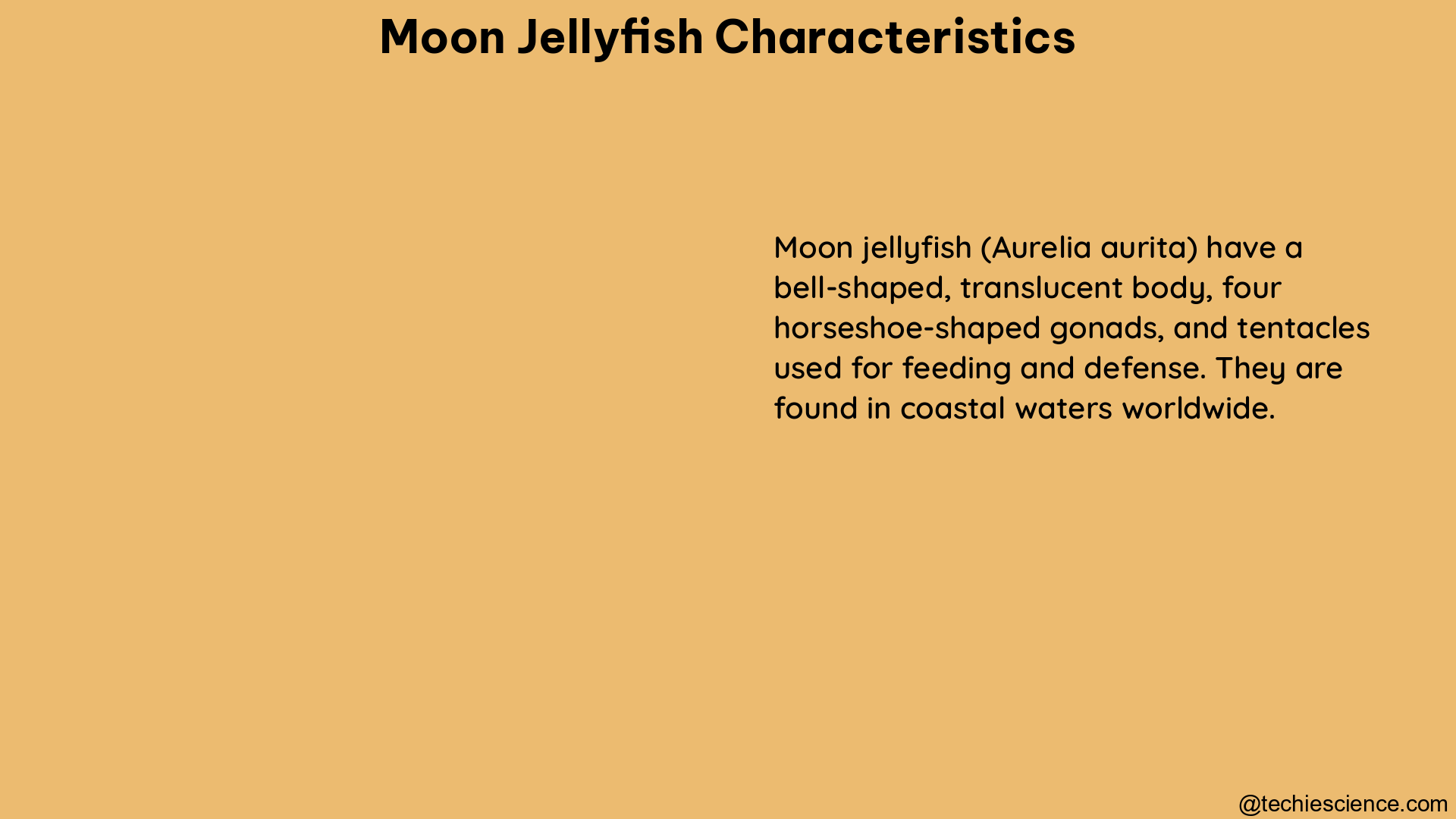Moon jellyfish, scientifically known as Aurelia aurita, are a common species of jellyfish found in the Atlantic, Pacific, and Indian Oceans. They are also referred to as “saucer jellyfish” due to their round, flat shape and transparent bell. This comprehensive guide delves into the intricate details and measurable characteristics of these fascinating marine creatures.
Size and Weight
Moon jellyfish typically range in size from 2 to 15 inches (5 to 38 cm) in diameter, with an average diameter of about 7 inches (17.8 cm) and a height of 3 inches (7.6 cm). Their size can vary depending on factors such as age, habitat, and environmental conditions.
Interestingly, moon jellyfish are composed of approximately 95% or more water, making them incredibly lightweight. Despite their delicate appearance, they have no brain, eyes, or heart, further contributing to their low overall weight.
Reproductive Organs

One of the most distinctive features of moon jellyfish is their reproductive organs, known as gonads. These four horseshoe-shaped gonads are located inside the transparent bell and are often visible as yellowish or pinkish structures.
The gonads play a crucial role in the jellyfish’s reproduction process. During the spawning season, the gonads release sperm and eggs, which then fuse to form free-swimming larvae called planulae. These planulae eventually settle and develop into new moon jellyfish.
Tentacles and Oral Arms
Moon jellyfish have two types of appendages: tentacles and oral arms. The tentacles are short and fringe-like, lining the edge of the bell. These tentacles are equipped with stinging cells called nematocysts, which are used to capture and subdue prey.
In addition to the tentacles, moon jellyfish possess four long, frilly oral arms around the mouth. These oral arms are responsible for moving food into the jellyfish’s mouth and stomach.
Swimming and Locomotion
Moon jellyfish move by pulsating their bell, which creates vortices that propel them through the water. This pulsating motion is a highly efficient form of locomotion, allowing them to swim horizontally with their bell facing the surface.
Interestingly, moon jellyfish can also form large aggregations or “blooms,” where they congregate in high densities. These blooms can contain millions of individual jellyfish, creating a stunning visual display in the ocean.
Senses and Neural Networks
Despite their simple nervous system, moon jellyfish possess a remarkable ability to sense their environment. They can detect light, dark, up, and down, and maintain a sense of balance in the water. Additionally, they have a sense of smell and taste, which helps them locate and identify their prey.
Remarkably, moon jellyfish use complex neural networks to control their locomotion, even when injured. These neural networks allow them to coordinate their movements and respond to changes in their surroundings.
Diet and Feeding
Moon jellyfish are carnivorous and primarily feed on zooplankton, which includes small crustaceans, fish larvae, and other microscopic organisms. They use their tentacles and oral arms to capture and move their prey into their mouth and stomach.
Interestingly, moon jellyfish have a unique feeding mechanism. They create a vortex with their pulsating bell, which draws in prey and directs it towards their mouth. This efficient feeding strategy allows them to consume a large volume of food while conserving energy.
Habitat and Distribution
Moon jellyfish can be found in temperate waters throughout the world, often near coastlines. They thrive in a variety of marine environments, from estuaries and bays to open ocean habitats.
Their widespread distribution is due in part to their ability to adapt to different environmental conditions. Moon jellyfish are resilient creatures that can tolerate a wide range of temperatures, salinity levels, and other factors.
Lifespan and Parasites
The natural lifespan of moon jellyfish is relatively short, with most individuals living and reproducing for several months. However, specimens cared for in public aquarium exhibits can live several to many years.
Like many other marine organisms, moon jellyfish are susceptible to parasitic infections. Various metazoan parasites, such as nematodes and trematodes, have been known to attack Aurelia aurita and other jellyfish species.
Density and Biomass
Moon jellyfish can form dense aggregations, with a mean density of 71 medusae per cubic meter. These blooms can contain approximately 174 million individual Aurelia sp. medusae, with a total wet weight of 28,600 tons and a biomass of 39.2 tons.
The high density and biomass of moon jellyfish blooms can have significant ecological impacts, affecting the food web and nutrient cycling in the marine environment.
Conclusion
Moon jellyfish are fascinating and intricate marine creatures, with a wealth of measurable and quantifiable characteristics that make them unique. From their size and weight to their complex neural networks and feeding mechanisms, these jellyfish continue to captivate researchers and the public alike. By understanding the intricacies of moon jellyfish, we can better appreciate the diversity and complexity of the ocean’s ecosystems.
Reference:
- Moon Jellyfish Behavior, Characteristics & Facts
- Moon Jellyfish
- Common Moon Jellyfish (Aurelia aurita)
- Moon Jelly
- Size and characteristics of aggregations of moon jellyfish (Aurelia SP.) in Tasmania, Australia

Hello, I am Bhairavi Rathod, I have completed my Master’s in Biotechnology and qualified ICAR NET 2021 in Agricultural Biotechnology. My area of specialization is Integrated Biotechnology. I have the experience to teach and write very complex things in a simple way for learners.